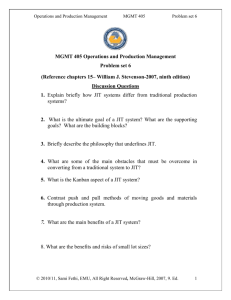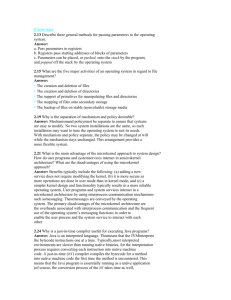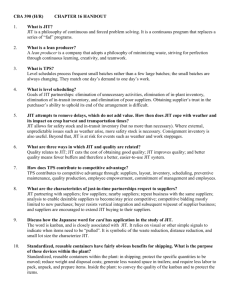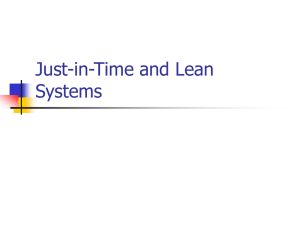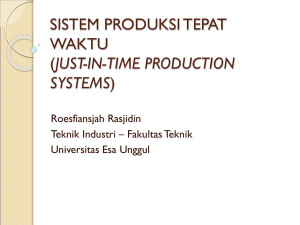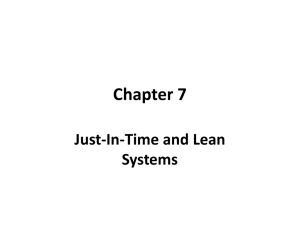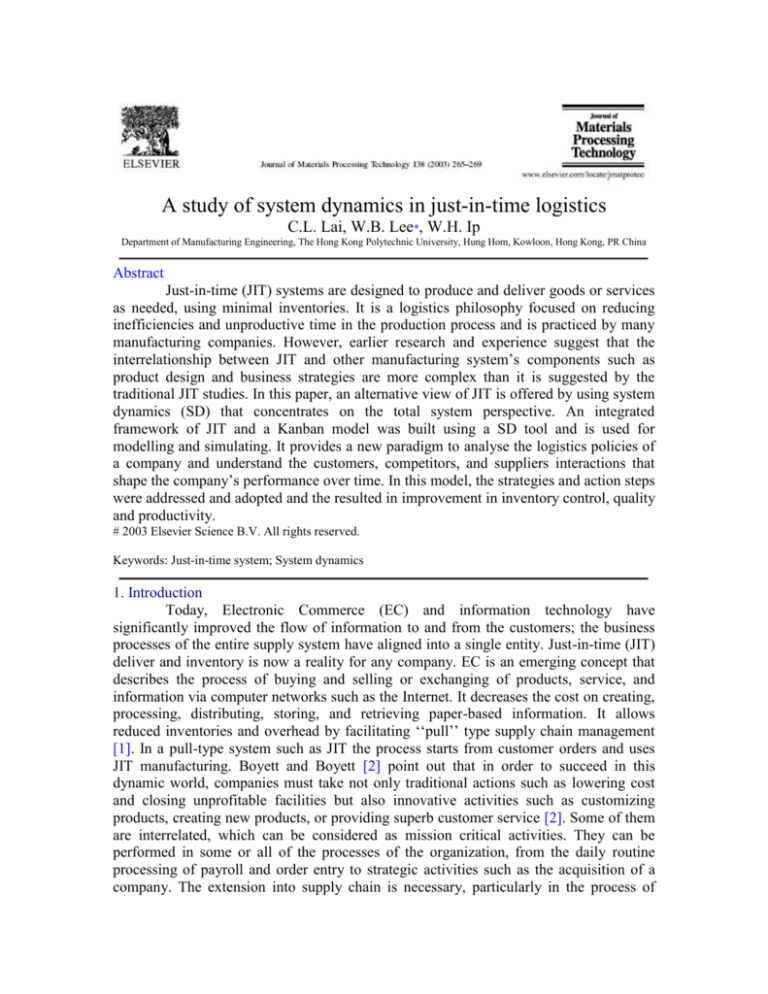
A study of system dynamics in just-in-time logistics
C.L. Lai, W.B. Lee*, W.H. Ip
Department of Manufacturing Engineering, The Hong Kong Polytechnic University, Hung Hom, Kowloon, Hong Kong, PR China
Abstract
Just-in-time (JIT) systems are designed to produce and deliver goods or services
as needed, using minimal inventories. It is a logistics philosophy focused on reducing
inefficiencies and unproductive time in the production process and is practiced by many
manufacturing companies. However, earlier research and experience suggest that the
interrelationship between JIT and other manufacturing system’s components such as
product design and business strategies are more complex than it is suggested by the
traditional JIT studies. In this paper, an alternative view of JIT is offered by using system
dynamics (SD) that concentrates on the total system perspective. An integrated
framework of JIT and a Kanban model was built using a SD tool and is used for
modelling and simulating. It provides a new paradigm to analyse the logistics policies of
a company and understand the customers, competitors, and suppliers interactions that
shape the company’s performance over time. In this model, the strategies and action steps
were addressed and adopted and the resulted in improvement in inventory control, quality
and productivity.
# 2003 Elsevier Science B.V. All rights reserved.
Keywords: Just-in-time system; System dynamics
1. Introduction
Today, Electronic Commerce (EC) and information technology have
significantly improved the flow of information to and from the customers; the business
processes of the entire supply system have aligned into a single entity. Just-in-time (JIT)
deliver and inventory is now a reality for any company. EC is an emerging concept that
describes the process of buying and selling or exchanging of products, service, and
information via computer networks such as the Internet. It decreases the cost on creating,
processing, distributing, storing, and retrieving paper-based information. It allows
reduced inventories and overhead by facilitating ‘‘pull’’ type supply chain management
[1]. In a pull-type system such as JIT the process starts from customer orders and uses
JIT manufacturing. Boyett and Boyett [2] point out that in order to succeed in this
dynamic world, companies must take not only traditional actions such as lowering cost
and closing unprofitable facilities but also innovative activities such as customizing
products, creating new products, or providing superb customer service [2]. Some of them
are interrelated, which can be considered as mission critical activities. They can be
performed in some or all of the processes of the organization, from the daily routine
processing of payroll and order entry to strategic activities such as the acquisition of a
company. The extension into supply chain is necessary, particularly in the process of
interaction among a company and its suppliers, customers and partners. In this paper, the
authors describe the JIT system, investigate the interrelationship of JIT in an EC
environment using system dynamics (SD) to produce ‘‘Ithink’’ high-level mapping.
Kanban pull system model is developed to analyse the logistics policies of a company
and understand the customer, competitors, and suppliers relationships.
2. Just-in-time
JIT philosophy, first introduced by the Toyota Motor Co. over 25 years ago, has
attracted much interest in its basic underlying concept of which provide only the
necessary products, at the necessary time and in the necessary quantity. It has also
received considerable attention from both industry and academics. Various authors have
discussed the JIT philosophy [3–6]. JIT can be described as a philosophy which attempts
to incorporate all aspects of the operation processes from incoming material, actual
manufacturing to deliveries. It has been developed to increase productivity through waste
reduction and increasing the value added on the production processes. One of the
elements of JIT is the Kanban method. Kanban is a ontrolled pull system. In a pull system,
parts move in the same direction, but the information concerning the processing of the
part is given by the subsequent process. These links between processes constitute
feedback loops. Many researches suggest that the interrelationship between JIT and other
manufacturing system’s components such as product design and business strategies are
more complex than it is advocated by the traditional JIT studies. The study of JIT in an
EC environment is even more complicate. The better the information system between a
company and supplier, the less inventory the company has to stock and the lower its costs;
the entire supply chain has many interdependent elements. The study of this relationships
require a much more sophisticated approach than it is available from the literature. In this
paper, we propose the use of system dynamic to investigate this complex dynamic
system.
3. A modelling framework
A conceptual framework illustrating the relationship between suppliers,
company and customers is shown in Fig. 1. JIT benefits the manufacturing firms by
reducing inventory, increasing flexibility, high product quality and increase productivity.
JIT promise to receive frequent and reliable deliveries of high quality parts in small lot
sizes and exact quantities. The implementation of EC in JIT system increases the
efficiency and processes the information flow even quicker between the trading partners
(customers, suppliers, transporter and their banks). In reality, very often the discrepancy
of JIT occurs in the supplier’s failure, slow response to the customers and communication
failure. Therefore, to avoid production stoppages, continuous update of supplier
information is critical. Suppliers and the customer must work closely with transporters to
ensure timely delivery of goods [7]. For successful JIT implementation, efficient and
reliable communication with trading partners is essential [8]. On the other hand, EC is the
business-to-business and business-to-customer communication technology that can be
integrated via the computers of various trading partners. Reliable and fast exchange of
business information among trading partners is its purpose. Firms that require rapid
processing and delivery of goods, business transactions involving a tremendous amount
of paper work, and buying and selling large volume of items; they are expected to benefit
the most fromEC. JITmanufacturing fits this descriptionverywell, and thus has the
potential to derive maximum benefits from it.
4. The system dynamic approach
In this section, an attempt is made to study the behaviour of the company,
customers and suppliers in order to determine the policies and strategies for those
company who use JIT in an EC environment. The model is developed using SD. SD deals
with the broad behaviour of the system and how it influences its own evolution into the
future which facilitates decision making. It can be seen as the strategy issues which
concern top management in the company [8]. Once the model has been built and tested,
the analyst can use it to test alternative policies and to redesign the system so that its
policies become more effective. The approach of SD was created and developed by a
group of researchers led by Forrester at the Massachusetts Institute of Technology (MIT)
in the late 1950s. This is the study of the information-feedback characteristic of industrial
activity to show how organization structure, amplification and time delays interact to
influence the success of the enterprise [9,10]. It is a framework for thinking about how
the operating policies of a company and its customers, competitors, and suppliers interact
to shape the company’s performance over time [11]. SD builds on information-feedback
theory, which provides symbols for mapping business systems in terms of diagrams and
equations, and a programming language for making computer simulation [12,13]. Ithink
is a tool of SD and a software methodology for modelling, simulating and redesign
manufacturing business [14]. Ithink software is a multi-level, hierarchical environment
for constructing and interacting with model. There are two major layers: the high-level
mapping layer and the model onstruction layer. An Equations View is provided to view
the entities on the model construction layer in a list format, for rapid modification of
variable definitions, and for easy exporting of equations from the model. Initially, the
authors construct the influence diagram of JIT before building a detail model. It is the
foundation on which quantitative models are built but is also a valuable device in its own
right for describing and understanding systems. Fig. 2 shows the influence diagram of JIT.
The solid lines show physical flows or material flows, they form the fundamental
principles of this modelling paradigm. Broken lines represent influences which are not
physical flows and indicate the information and action parts of the paradigm. The actions
should be deliberate choices by the managers of the system or they may be the
ungovernable reaction of nature of the state of the system. A box denotes an external
driving force over which the system has no control and to which it must respond. In this
case, the demand is a driving force. It is set by human action but, having been set, the JIT
system simply has to respond to whatever it is. A ‘t’ and ‘_’ sign means that the variable
at the tail of the arrow changes proportional and opposite respectively. Items in bold are
constant factors. Fig. 3 shows the information flow and material flow in JIT
manufacturing system using high-level mapping of Ithink. The critical elements include
quality, maintenance, production and waste elimination. JIT systems are designed to
produce or deliver goods or services as needed, using minimal inventories. It is actually a
philosophy that focuses on reducing inefficiencies and unproductive time in the
production process. Embodied in the JIT system are the concepts of continuous
improvement and total quality control, as well as employee involvement and inventory
reduction. In this model, much attention has been given to JIT manufacturing under the
name of the Kanban-controlled pull system, which differs from the conventional push
system. Kanban in a pull system is a signal attached to standard containers which issues
the production and withdrawal of parts between work stations. It is viewed as an
information system that controls production. The most basic Kanban system uses
single-card signal. Different methods for the calculation of the number of Kanban signals
have been designed. Bitran and Chang [15] have designed a mathematical programming
model for the Kanban system in a deterministic multi-stage production environment.
Markovian models of a batch manufacturing system by using single-stage single- and
dual-card Kanban system and a twostage Kanban system to study the effects of Kanban
size on inventory and backorder costs [16]. Moreover, provided a thorough explanation
of the Kanban system and the conditions for its implementation using a SD model for a
threestage transfer line [17]. Bara and Singh [18] used a SD modelling approach and
provided a comprehensive analysis of push, pull and long-pull systems and investigated
the effects of these systems on WIP inventories and throughput. In Fig. 3, the thin arrows
show the information flow. There are forward and backward flow between the production
and quality unit. This information is used to continuous improvement of the operation.
Inspection is conducted on the products according to the specification and standards. The
quality report of the product is returned back to production to improve the operation by
adjusting the machine or through other improvements methods. The quality unit also
continues to seek ways to improve operations such as the introduction of total quality
management (TQM). JIT will be successful if a company produces quality goods at
source i.e. ‘‘doing it right first time’’. Thus the information from quality to production is
very important. Maintenance is also a critical part for JIT. Maintenance unit should keep
records of breakdown, repairs and costs fromthe production unit, so as to predict the time
for machine breakdown, carrying maintenance, replacing equipment and machines.
Elimination of waste is the main theme of JIT; the level of scrap should report to the
production. Adjustment is needed to improve the scrap. Scheduling, assembly planning,
distribution of work force and bill of material also should be provided to the production
and guide them to eliminate the unnecessary wastes. Besides the high-level mapping,
Ithink can show us the detail of each unit which can be seen in construction model layer.
5. A case study
The modelling approach, data collection and analysis have been experimented
and conducted in an electronics factory. To align with the application of EC in the
company, it is necessary to improve and integrate with JIT supply chain; JIT delivery and
inventory are found to be essential to support EC. Before the improvement through JIT,
there are many operation problems; for example, it was found that records on the shop
floor were erased deliberately by the operators to hide the scrap parts which they threw
away. The actual WIP on the record was thus always inaccurate and unreliable. Moreover,
the information about the customers and supplier were often incorrect. After JIT
implementation, many of these problems were eliminated. EC now provides a
business-to-business platform between customer and the company, and supplier and the
company. Reliable and fast exchange of business information among them is achieved.
This company has taken four steps to ensure JIT is successful. They are summarized into
the following:
1. Keep patience: always allow adequate time for the production people to learn,
understand and try out the concepts of JIT manufacturing.
2. Small steps: each method change should have a clear target and the scope is small
enough to let people manage the implementation at ease. Seeing the results achieved,
people would generally have higher confidence to prepare for another step.
3. Simplicity: simplicity in inventory and material control allows production people to
have high physical visibility of the material flow by means of visual aids like standard
containers, colour coding of containers/Kanbans which prevent error in handling.
4. Integration: a sound inventory and material control system will not work if the other
factors of JIT are not integrated in the manufacturing.
In this study, the SD model of Kanban signal is used to identify the problem of long
production run. The new system can now maintain the synchronization of inventory and
material flow between the production cells. In addition, the reduction of WIP can be
simply done by gradual withdrawal of Kanban signals circulating in the production floor
and reduction of setup time for model changeover. Now the company is able to manage
and carry out different types and models of business transactions such as customer,
supplier, production and delivery without much human interventions. The inventory and
material stored at the production, warehouse, vendors and partners can be linked toWeb
servers and database servers to conduct EC. All information can be real-time and JIT,
capable of storing and uploading information of the products whether those areWIP,
produced or sold.
6. Conclusions
This paper proposes a SD methodology for studying a new generation of JIT in
an EC environment. EC facilities the JIT manufacturing; it integrates the information
flow from the customer to the supplier, forming a single supply chain. The fast and
accurately information flow minimize the error and improve the communication in
customer, supplier and the company. However, to make the best use of EC era, effective
policy and decision making should be addressed. SD allows manager to understand the
JIT and EC behaviour and their relationships with the company and its partners. It helps
the manager to make policy and decision through a systematic approach using model
design and development. In this paper, the authors have described some of the SD models
of JIT. These are merely the initially steps and attempts to the design and construction of
a comprehensive model of JIT under EC environment. Further research is required to
extend the variables and elements and to conduct experiments to investigate the stability
of the system under various conditions such as the sudden increase in demand and
random demand; experimentation on the system behaviour of different types of customer
and modes of manufacturing.
Acknowledgements
The authors would like to thank The Hong Kong Polytechnic University;
Research Project No. G-V927, for the support of this research.
References
[1] E. Turban, J. Lee, D. King, H.M. Chung, Electronic Commerce—A Managerial
Perspective, Prentice-Hall, Englewood Cliffs, NJ,1999.
[2] J.H. Boyett, J.T. Boyett, Beyond Workplace 2000: Essential Strategies for the New
American Corporation, Dutton, New York,1995.
[3] Y. Sugimori, K. Kussunoki, F. Cho, S. Uchikawa, Toyota production system
materialization of just-in-time and respect-for-human system, Int. J. Prod. Res. 15 (6)
(1977) 553–564.
[4] Y. Monden, Adaptable Kanban system helps Toyota maintain just-in-time production,
Ind. Eng. 13 (5) (1981) 29–46.
[5] O. Kimura, H. Terada, Design and analysis of pull system, a method of multi-stage
production control, Int. J. Prod. Res. 19 (3) (1981) 253–541.
[6] E. Bartezzaghi, F. Turco, The impact of just-in-time on production system erformance:
an analytical framework, Int. J. Oper. Prod. Manage. 8 (1) (1989) 40–62.
[7] A.T. Sadhwani, M.H. Sarhan, R.A. Camp, The impact of just-in-time inventory
systems on small businesses, J. Accountancy 163 (1) (1987) 118–127.
[8] M.M. Helms, Communication: the key to JIT success, Prod. Invent. Manage. J. 31 (2)
(1990) 18–21.
[9] R.G. Coyle, System Dynamic Modelling: A Practical Approach, Chapman & Hall,
London, 1996.
[10] C. Lin, T.S. Baines, J.O. Kane, D. Link, A generic methodology that aids the
application of system dynamics to manufacturing system modeling, Int. Conf. Simul.
457 (1998) 344–349.
[11] J.W. Forrester, Industrial Dynamics, Ore: Productivity Press, Portland, 1961.
[12] R. Pugh, The Executive Training System, Mass: Pugh-Roberts Associates, ambridge,
1988.
[13] B.H. Richmond, P. Vescuso, S. Peterson, Stella for businesses, High Performance
System, Hanover, NH.
[14] D.R. Towill, System dynamics-background, methodology, and applications, Comput.
Control Eng. J. 4 (5) (1993) 201–208.
[15] G.R. Bitran, L. Chang, A mathematical programming approach to a deterministic
Kanban system, Manage. Rev. 3 (3) (1987) 155–160.
[16] U.S. Karmarkar, S. Kekre, Batching policy in Kanban systems, Working paper no.
M8706, Graduate School of Business, University of Rochester, New York, 1988.
[17] R. O’Calahan, A system dynamics perspective on JIT-Kanban, in: Proceedings of
the International Conference on System Dynamics Society, Sevilla, Spain, 1986, pp.
961–1004.
[18] J.K. Bara, N. Singh, System dynamics modelling and analysis of just-in-time
manufacturing systems, Working paper no. 01-91, Department of Industrial
Engineering, University of Windsor, Windsor, Ont., Canada, 1991.



